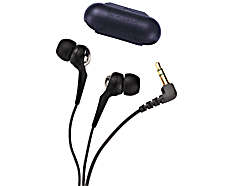
3/11/99 New - dejanews queries at bottom.
>I don't know if you're still maintaining the Earbud FAQ, but if you are, you really should see this model. The MDR-EX70LP earbuds. A closed-type Fontopia design. An *unbelieveable* 6-23,000 mhz range, and they *sound* like a professional pair of studio headphones. I was totally blown away by their sound, and if you need it I'll give a more detailed analysis of what they sound like and their specs and such.
>They may be $49.00, but I spent that in an eyeblink once I heard 40 seconds worth of music on them. This is, by far and away, *the* best pair of buds I've *ever* owned. Period.
--GonzO
MDR-EX70LP - $50 list.

Someday I should update this page for Sony's latest models. -- Michael Hoffman, December 10, 2000.
___________________________________
New Koss in-ear earbud -- The Plug
The Plug features a dynamic element that is positioned just outside the ear and connected to a tubular port structure that is inserted on a soft expandable cushion into the ear canal. The soft foam cushion expands for a custom fit to improve isolation and enhance deep bass and treble clarity. The Plug features special ear cushions made of hydrophillic, formed urethane, for a custom fit each and every time it is inserted into the listener's ear. The custom fit enhances isolation when you want to plug out ambient sounds that interfere with the listening experience. The Plug has a frequency response performance of 10-20,000 Hz and the full Sound of Koss. Combined with your favorite music and a portable sound system, it is the ultimate accessory on the go.
A mute switch on the cord provides connection to the outside world without having to un-Plug. Four extra ear cushions and a colorful, vinyl carrying case are included.
The suggested retail price for The plug is $19.99.
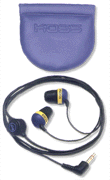
___________________________________
Incredible advances in technology over the years have provided a way to put 3-D sound in a stereophone without the addition of bulky equipment or a heavy stereophone. The new ambiance enhancement circuity incorporated into these stereophones delivers large-as-life 3-D sound from a small box attached to the stereophone cord. This box measuring 2"X1"X1/2", features two Panoramic Source Control slide bars that control the left and right crossfeed, a Ambiance Expander switch and a Comparator switch.When the Ambiance Expander switch is flipped from the "0" position to the "-180" position, the difference is immediate- sound so electric and defined you'll feel as though you're right on stage with the musicians. This switch expands the center channel on your recording, giving you the feeling of being totally surrounded by the music. Use the Comparator switch, marked "IN" and "OUT", to compare the difference between Phase I (standard stereo) sound and 3-Dimensional Phase II sound.
The two Panoramic Source Controls (PSC) manipulate the left and right crossfeed drawing you closer and closer to the center of the performing musicians. At the fully advanced position, the delicate, intimate sounds present on the recording become clearly defined. Sliding the PSC bars separately from one another allows you to move among the different instruments, mixing the sound in your head. Pull certain instruments forward. Cast others back. Create your own perfect listening experience.
For the discriminating music lover on the go, the PortaPro/EX offers the exceptional sound quality of the PortaPro Stereophone with the 3-D capability of the Phase II circuitry. The neodymium magnet structure of PortaPro/EX element delivers a frequency response of 15-25,000 Hz for all the deep bass and treble clarity known as the Sound of Koss. Oxygen free copper voice coils reduce the moving mass of the diaphragm and improve signal transmission. Supra-aural, foam ear cushions provide lightweight comfort while delivering the deepest bass found in a open-air, portable design. The unique 3-position Comfort Zone temporal pad design redirects pressure off the ear and onto the temporal bone for a secure fit and greater comfort during extended listening. The 3-position allows for adjustment of the pressure of the ear cup on the ear relative to the listener's head size and fit preference. The Porta-Pro/EX stereophone is collapsible for protective storage and transport. Suggested retail price: $64.99
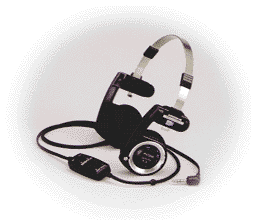
(Now, if only it had a pre-settable 9-band EQ curve, I'd be in headphone heaven.)
There is great disagreement about:
After testing many headphones and earbuds and applying my extensive experience tweaking equalizers, I think that earbuds actually have the potential to sound even *better* than standard headphones. In any case, all headphones and earbuds need a new approach: a calibrated equalization curve built into the player, to yield flat response. Megabass is a step toward such a compensation curve.
Like the Etymotics, earbuds have the potential to have smoother response than even the best popular standard headphones, such as the Sennheiser 580's. I've dialed in some truly vibrant, open sound using equalization together with $10 earbuds. It is easy and straightforward to equalize earbuds; just do anti-rolloff to a greater or lesser degree, and leave the rest flat; there aren't mysterious jags hidden along the entire spectrum that need unique shapes of compensation. I'd rather trust my ears than the common assumption that earbuds are inferior. If the conditions are right and the appropriate, ordinary EQ compensations are made, earbuds can be superior, rather than inferior, to good standard headphones. It's simply a matter of starting with a decent earbud driver, and providing the inverse of the earbud driver's frequency response.
If someone shows me a measured response curve of an earbud and it's rough and jagged, I will change my view somewhat, but in any case, I think that eq-compensated earbuds at least *can sound* unusually smooth and natural. Players need more fancy curves to compensate for specific earbud models.
"Though I like the R3 stock earbuds even better than the 888's, I can't stop seeking for even better sound, as I believe it can be a lot better. If I press against an earbud I get very powerful bass, so it is possible. I will keep on looking, and if I find something interesting I will let you know. Please let me know your findings on this matter." (from a private email to me)
Some people haven't been lucky and haven't heard the one or two models that are really good. No wonder they think earbuds are a poor packaging and sound poor. I was starting to suspect that *some* Sony stock earbuds (included with the player) sound great, and some sound lousy.
Of the earbuds I've tested, I recommend the low-end Sony models such as the 821 (MDR-E821LP): very inexpensive, wide-response, no humps, good coupling, case included. Their only flaw: a little too much high-treble, so that cymbals tend to overshadow the rest of the treble. People have complained about certain earbuds having too much treble; they might be referring to this. If you want less high-treble, choose from the higher-end units (8n8 such as 848). Some people claim that the high-end such as 888 have a lot of "treble", but I know that my 868 has extra mid-treble with less high-treble, compared to my 817 [821] or 807V, and the other high-end units I demo'd in a store had the same overall treble sound as the 868: that is, less high-treble than the 817 [821]. The high-end have too much sibilant mid-treble at first; several people reported that this "smoothes out" after break-in. After a reasonable time, my 868's still sound like they have a lot of mid-treble with much less high-treble than the 817s [821's].
I don't listen to my 238L's -- not enough mid-treble, not enough high-treble. I tend to alternate between 817 (now redesigned as the MDR-E821LP) and 868.
Headphone manufacturers should stop shooting for the impossible goal of flat headphone response, and think instead in terms of *systems*, combining calibrated eq, good drivers, and cross-channel delay.
Headwize.com - Headphones resource site
Headphone.com - lots of info about headphones
(800) 222-7669 - Sony parts and product info
Detailed Table of Sony Earbuds (Word 2.0)
There are many Sony earbud models, but there are only 4 or 5 unique drivers/housings.
_____________________________________________________________
MDR-E811LP:
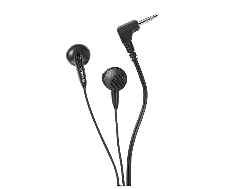
MDR-E821LP: [I have these]
.gif)
MDR-E821V: [I have the predecessor, 817V]
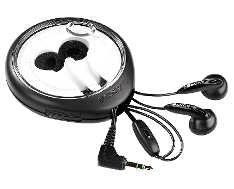
_____________________________________________________________
MDR-E848LP:
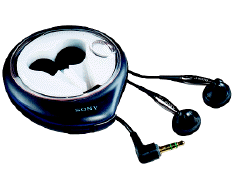
[Where is the MDR-E868LP?] [I have these]
MDR-E888LP:
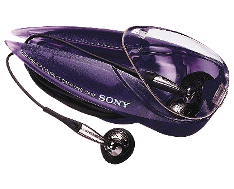
_____________________________________________________________
MDR-E228LP:
.gif)
MDR-E238LP: [I have these]
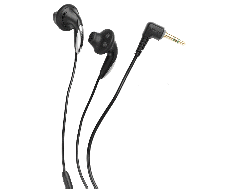
MDR-E268LP:
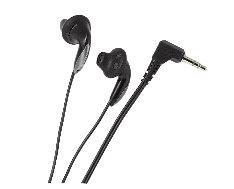
_____________________________________________________________
These two sound different, but it's pretty arbitrary which one you pick. Overall, they sound equally good or equally flawed, as far as frequency response; the humps and dips are merely in different places in the spectrum. Neither of them has a major hump or dip, aside from bass rolloff. They both have a fairly good coupling with the ear canal. Given that their flaws are equivalent, just shifted to different places, I'd have to recommend Sony's low-end earbuds, based on price.
I did a demo of the ~$10 817 [821] (same driver and housing as the other 8n7's) against the 868 ($40, almost the most expensive). The 868's have been broken in for several days, 24 hours (in case it makes any difference). I wish I had a simple response curve for these instead of trying to hear the curve. But I'm sure of the following major differences, analyzed in terms of 9 divisions of the frequency response curve (I wish eq's had 9 bands, not 10 -- easier to label, such as "low-midrange"). (See Michael Schuster's note in the Aiwa section below - he dislikes the low-end Sony's.)
The low-end models overemphasize high-treble, and have a lot of mid-bass, and a fair amount of low-bass:
low-bass: less
mid-bass: more
mid-treble: less
upper-treble: more
The 8n8 models have more mid-treble, but less high-treble; and has a little less mid-bass with a little more low-bass:
low-bass: more
mid-bass: less
mid-treble: more
upper-treble: less
Neither curve is better; they are equally imperfect -- at least they are both smooth; no really jagged response peaks or dips. I really need to draw the two curves on a sheet of paper and scan and upload it.
The dream earbuds I am looking for would be an average of the Sony low-end earbuds and the 868: these wouldn't have so much high-treble as the 817 [821], and would have more mid-treble (thus sounding less cold than the 817 [821], while still having more upper presence than the 868). The ideal earbud would have the same amount of low-bass and mid-bass -- it should have more mid-bass than the 868.
I compared the mid-bass and low-bass using _No Sleep til Hammersmith_, a live album by Motorhead, with prominent bass guitar as well as kick bass drum. With the 868, the bass leads sounded thin, like a guitar, rather than full and meaty -- and the bass drum (low-bass) drew too much attention away from the central region of the bass spectrum, which is occupied by the bass guitar. On the other hand, with the 817 [821], the cymbals were overly present, and distracted from the lead guitar. Although wide frequency response is important, you don't want extreme bass (low-bass) overshadowing the mid-bass. And you don't want the extreme, high-treble so loud that it weakens the presence of the mid-treble. (I assume that you always have a good amount of upper-bass and lower-treble; these are easier to reproduce.)
The low-end Sony earbuds are light, small, durable, fit well for most ears, are comfortable for most ears, and have a lot of bass (including low-bass) and treble (especially upper-treble), and are inexpensive ($9-$30).
My 807V and 817 [821] have the symmetrical wires; the left earbud does not have a much shorter wire than the right earbud.
A good thing about studying the Sony line is that you can find them most everywhere - particularly the 807, 807V, and 817 [821]. Some hi-fi stores don't carry the 817's [now 821's], but they carry the [old] 837's [now no low-end ones with gold plug?] with the same drivers but a gold plug, to make a secure connection.
>My MDR30 came with an ad for MDR-ED238L Fontopia Ear Buds. Any opinion on these?
>Paul Buckley
These sacrifice too much treble, in my opinion, to earn a little more mid-bass.
Some owners recommend these, but I think they have too little mid-treble and upper-treble, and too much upper-mids and lower-treble, resulting in a moderate "can-like" sound. They have the most bass, at least the most mid-bass. This model is not recommended by me, though most everyone is happy with the quantity of general bass. The chamber shape and mouth of the 238 seems to introduce resonance problems, similar to closed-back headphones. The bass sounds quite good on mine, *if* they are inserted into my ears. (The mid-bass dominates over the low-bass, unlike with the low-end earbuds, which have a balanced amount of low-bass and mid-bass. I think the low-end Sonys have the best balance of mid-bass versus low-bass.)
238 has the highest ratio of mid-bass to low-bass. Then the low-end buds, then finally the 868 has the least mid-bass, with the most low-bass -- meaning that the bass isn't quite full-bodied in the heart of the bass spectrum. (This all assumes a typical megabass compensation setting.) I own these 3 models and have focused on comparing these ratios -- but most people just think in terms of "how much bass is there". You might not want to be so detail-oriented, but I think you will hear the difference, even if you can't specify it in terms of frequency response. Bass differences are important, but treble differences are greater than bass differences in Sony earbuds.
The coupling factor: you can rotate the shaped part. They have more mid-bass fullness than my 817's [821's]; the 817's have the powerful low-bass but not so much mid-bass. The 238's have a hill-shaped response, with the peak centered around the mid-bass. See also: Coupling.
The driver housing and stem is one-piece. Instead of a front grill and a cushion, there is a tapered horn with 7 holes that goes into the beginning of the ear canal. These collect ear wax and you have to clean your ears vigorously every few hours.
The plastic hurts (irritates) my ears badly. Another owner reported them feeling very comfortable later. I am used to cushions on earbuds; these don't come with any.
At first, these have less low-bass than the low-end Sony earbuds (unless pressed against the ear) - but they might loosen up in 2 weeks. They also (at least initially) have less upper-treble than the low-end earbuds; instead, they have have sibilance-spasms: when the music hits an "s" or "t" sound, there is a sharp peak in the mid-treble, caused by the headphones. This is the well-known "roughness" that is supposed to go away and "smooth out" after the break-in period; supposedly this spasm turns into smooth high-treble. Something similar is supposed to happen with the low-bass too.
A little *big* and heavy, coupling not quite as good as the low-end models, thus bass is practically weaker. I'm continuing to test and live with these, comparing them to my 238 and 817's. [now "821's"]
>I've been using the 868 for quite a while, and I recently bought the MZ-R30. The earbuds that came with it were surprisingly good and I find myself constantly comparing between the two. When I first bought the 868's, I hated them. I immediately noticed their lack of deep bass, and I found the design to be very uncomfortable. Since then I've really gotten use to them. The R30's (i don't know the actual model #, they're silver on the sides with a remote and a gold plug) are the complete opposite. Very strong bass, but the overall sound quality isn't as good. I've got this one song with a very deep bassline that the 868 just can't handle (unless at a very low volume,) the left one, especially, starts cracking at every beat, but the R30 has no problem with it. With other tracks, however, the fuller sound of the 868 clearly outshines that of the R30's. I find myself having to switch back and forth on a regular basis depending on the nature of the song that i'm listening to. Are the 888 the solution to my problem? Are they really worth the extra 40$ that they cost over the 868?
>I bought the 868's and felt that the sound was good but that they were also very umcomfortable. About a month after I bought them they broke where the wire enters the device and then it happened with the other ear.
I own many sets of earbuds including Sony high-end. But I like the $10 Sony earbuds best of all. And they are comfortable except for *long* sessions. The bigger Sony's irritate my ears almost immediately.
Let me put it this way: everyone who is looking for earbuds should own a cheap pair of Sony earbuds, for only $10. I haven't heard their new "reduced sound leakage" design though.
Date: Fri, 20 Feb 1998 16:22:39 -0800
From: Ken Savage
Subject: Sony earbuds
>I have a pair of MDR-E565's that I've owned for about a year and a half now. I don't think they're made any more, but prior to them, I had a pair of 868's. The 868's (bless their souls) were nice earbuds, but they started to buzz in one ear, so I put them out of their misery. The 565's were more expensive, between the 868's and the 888's, and I'm quite impressed with the sound quality. Like most earbuds, they're not as powerful in the bass end, but if you push down on them, bass goes up a *lot*. I use them in my MD player (E30) and I'm sure the day THEY die, a few tears (of frustration at finding and breaking in an expensive pair of buds) will be shed.
>Ken
Some owners say that the 888's sound terrible, and some say they sound great; some claim they sound terrible for two weeks and then they sound great. If my $40 868's sound much better after break-in period, then I might gamble $80 and buy (and break in) a pair of 888's; I'll update this page as my tests progress.
"At first the sound was terrible, no bass, harsh treble. Really dissappointing. I knew earplugs like these aren't exactly high end, but this was bad! With bass boost on the MZ-E30, it was worse - more bass all right, but also more treble spasms. The more bass boost the more terrible sound, thin and ugly. Well, after a few weeks things started to change! They 'loosened up'. Now the bass is there, deep and realistic, treble is right, I'm impressed! (it is important to push them into your ears). Extreme 's' and 't'-sounds are only there when the material says so."
From my in-store testing of a pair that might not have been broken in: these $80 earbuds had less midbass, less low-bass, and less upper-treble than the low-end earbuds. People give very conflicting reviews of these.
The shiny pearl-blue metal accent calls too much attention to itself; it looks like earrings.
>I have an MZ-E30, and had an MZ-R3. Upgrading the R3 stock headphones to a pair of Sony's top of the line E888 headphones yielded excellent sound. However, when the E30 stock earbuds were replaced by 888's, the sound was much poorer, treble was really rolled off, and the sound was sort of on the soft side. Some people might like it, but it is FAR from being representative of the music.
>The E30 and R3 both had the same factory headphones (E838), and I've also tried swapping them.... Same results.
>Either there is some sort of impedance mismatch, or it could be the megabass settings that are different on both. I've tried different settings too.
>Try Sony MDR-E888, with biocelluloid membrane. Do -not- try them in the store before you buy, if you are not sure they are allready well used - they sound terrible the first couple of weeks. Now I enjoy these so much that I even use them at home. I prefer them to Koss Porta Pro (which is 'warmer', but a bit muddy in bass and midrange, and not so huge and spacious), Sony MDR-D65 (has thin tinny treble and tiny bass because connection to the head (my head anyway) is not good). They even come really close to my AKG 270 (which is not intended for portable use at all (and cost twice as much)). I never believed tiny earbuds could sound so huge, dynamic and weighty. If I should pick on something, the treble is perhaps still a little bit sharp (on the MZ-E30) [sibilance spasms?], but this may just as well be because most studio recordings are a sonic mess anyway.
"Don't buy Sony's 888 top model, since they sound lousy. There is hardly any bass, even if you max your bass boost. They costed me $75 and are now in a drawer, with the rest of the earbuds I've tried. I currently still use the ones that came with my first Sony portable, the MZ-R3, rather than the 888's. I find the earbuds included with this model (there's no number on them, just the word MiniDisk) very good, rich bass and exellent mid and high. No other earbud has topped the R3's stock earbuds so far. For now, I can only say: don't buy the expensive Sony 888's!"
I have spoken with sincere, experienced salespeople who consider the 888's the world's best earbuds, and the 888's have gotten some favorable remarks in the mailing list. Some owners say buy them, some say don't.
From: "Toby & Kan Lai" Subject: Earbuds for R50 Date: Fri, 13 Mar 1998 19:46:23 -0500
>I want to replace my Sony MZ-R50 stock E838 earbuds. Not that I don't like them, in fact, I do, but the phones wire is damn to short (designed to use with the remote control). Now I want to find another pair that would sound close, if not the same, to the E838s. What's your suggestions? I'm considering the E848s because 1) they are in the same 8x8 class, and 2) according to your Sony earbuds table, the sound characteristics "fair bass, fair treble" suits my needs.
>Any suggestions/pointers are greatly appreciated.
>Toby Lai
"I currently still use the earbuds that came with my first Sony MiniDisc portable, the MZ-R3, rather than the 888's. I find the earbuds included with this model (there's no number on them, just the word MiniDisk) very good, rich bass and exellent mid and high. No other earbud has topped the R3's stock earbuds so far."
"Last summer I bought a MZ-E3, with horrible earbuds included with it. I also bought the 888's. I also bought the 238 ("Groove") model, which should have enhanced bass sound because of the new cap design. Well, bass sucked [! I question this -mh], as did mid [too much??] and high [too little??][sucked in what way?] sound. After all these comparisons, I'm back to the MZ-R3 MiniDisc player's stock earbuds, because they sound better than the 238 earbuds, the 888 earbuds, and the E3 MiniDisc player's stock earbuds."
Date: Thu, 19 Feb 1998 13:03:38 -0500
From: Kevin Brower
>Are you familiar with Sony's MDR-E464 earbuds? I purchased them about 8 years ago and they were high end at the time. I continue to use them today instead of the earphones that came with my R3 unit. They still sound great. Do you know what model Sony currently has that compair to the MDR-E464? What earplug do you beleive is the best?
>Kage
Date: Thu, 19 Feb 1998 03:16:52 EST
From: Ellissan at aol.com
>Have you ever compared Sony's MDR-NC10 Noise Cancelling headphones? I use them when I travel with my MZ-R30 and MZ-E30. They are a little more expensive than the others Suggested retail is around $199. But I am convinced that I can't find anything better in the size category.
>Anyone who travels alot by plane or who is consistently communting by rail will appreciate the amount of outside noise reductions these puppies provide. You don't even have to have them connected to a source to appreciate the cancellation effect. I get a kick when the flight attendants come around asking people to turn off their portable electronic devices (because I'm still wearing the headphones at this point) and they'll ask me to put my MD away....then I show them the miniplug which isn't plugged into anything. Anyway, if you have the means...I highly recommend them.
>Pete
Date: Thu, 19 Feb 1998 05:34:15 PST
From: E Davantes
>I am a military resident of Japan. Your page is great and well-needed, considering the mass of awful sounding earphones out there. I've wasted lots of cash on crappy earphones and have gone through a countless number of earbuds and headphones. These earphones I'm about to explain are the best I have heard. I even almost purchased the Sony StreetSounds hours before seeing your page, they look too cool to sound so bad. [search this page for "street"]
>I almost died not reading anything about my favorite earbuds on your page. I bought them overseas, the Sony MDR-NC10. They are noise-canceling earbuds that are optionally powered by a single AAA battery. They have one large button on a "remote" that allows you to hear your surroundings as you press the button. The buds are the size of hearing aids but the sound on this model surpass even the best full-sized headphones. The sound can be compared to listening to a boomin' car system and with few instances of distortion. I cannot begin to explain the bass on these things! Without power, the bass is deep and clear. When powered, they really *kick*. The treble is average-to-good without the AAA battery, but when powered, they have strong mid-treble and have the sweetest high's. These are the best sounding earbuds I have heard-hands down. [are they earbuds, or headphones?] I use a Aiwa AM-F5 MD recorder that has about the same bass as a MZ-R50. I can send pictures in case you haven't seen them before.
Etymotics page at Headphone.com
>Date: Sun, 21 Jun 1998 22:12:12 +0800
>From: "Mark Jones"
>To: hoff at amptone.com
>Subject: Earbuds and the Etymotics in-ear phones
>I am, what I consider to be a ("serious") portable audio listener. Your comments on earbuds was fascinating to me. Until a week ago all I used was either the MDR-E827 or the MDR-E888. I picked the 888's up in Hong Kong a few months ago, and was, and still am disappointed in their bass response. The 827's I have had for over a year, and until a week ago there was nothing on the market which came close to their bass response.
>Now a week ago I made a significant investment and purchased the Etymotics Ear Canal Phones. I say significant investment, because a laid out $270.00 for these things! These phones fit in your ear canal, and provide 25db isolation. Everytime I pout them on, it takes me a few minutes to crawl back up from the floor! The sound is just amazing! The bass you don't feel pounding at your chest, you actually hear it! These things are just amazing!
>The problem with them though is that you need a good amp to push them. In addition to this purchase I bought a headphone amp from HeadRoom ("Supreme"), and with my Sony MZ-R50 coupled to the Supreme Headphone Amp and the Etymotics, well I have true portable hi-fi audio! The investment was $850.00 total, but if you are serious about portable audio, then this is a good investment.
>I spend allot of time on the road, international travel, and not having quality audio for months on end is just not exceptable to me. My portable system includes the Sony MZ-R50 MD Recorder / Player, a Sony D-E805 Portable CD ("I love it!"), a pair of Bose Room Mate II Self Powered Speakers ("the bass is awesome"), the HeadRoom Traveler System, and the Etymotic Ear Canal Phones.
>Now, I still use the MDR-E827's quite often. They are moisture proof, and have excellent bass, and fit my ears nicely. When I am riding my bike through southeast China, I have a problem using my Etymotics and having them fill with sweat! The MDR-827's are just as amazing to me as the Etymotics. And the sound seems to just get better and better the more I listen to them. And with the 827's coupled directly to my MZ-R50 MD, their is no need for an amp, you got all the volume you would need.
>The 888's just don't have any bass, even after a 2 week break in period they did not improve! I have even tried cushions over cushions, and this did not help. I would not recommend them to anyone, though no one individual hears the same, so you be the judge. I also got some Senn's and Grado headphones, though don't listen to them very often, especially since I got the Etymotics. Seriously, there is nothing on the market which can compete with the Etymotics! These things are simply amazing in every sense of the word!
>Just saw your page linked from the minidisc page. I've got some 888's bought in the hope they'd sound good - they seem OK, but so far I've only used them on the CD player output of my SGI 02 CD-ROM drive at work - not the best quality of sound! I must take them home some time. I had a pair of 575's (?) which used to sound nice, but then they stopped working.
>There are a pair of Stax earbud electrostatic 'phones. Actually they may be in the ear with headband (?) If you want to know more, let me know, I have some literature at home, and a scanner at work.
>Amardeep Bhattal
Magnolia Hi-Fi said Sennheiser earbuds sounded disappointing; they said Sony's high-end earbuds sound much better (with cushions, after break-in, as usual).
Someone said the Sharp earbud was really good, that came with a particular model of Sharp player.
Date: Wed, 5 Aug 1998 17:47:53 +0100
From: Mark.Howard at wdr.com
>I had a look at your earphone page - very interesting and good news as I much prefer to stay with earbuds.
>I'm looking to order Sharp's 311 from Japan but concerned that its headphone amp is only 5mW. I'm worried that the volume will be too low like Sony's EP11.
>Are you aware of any earphones that I could get that would ensure volume is adequate? Nothing excessive - just up to the level of the Sony R30 for instance.
>Mark
I bought some cheap Aiwa earbuds. They have peaky low-treble or upper-midrange (fatiguing). The wire doesn't enter each driver housing in a secure way; the resulting rubbing creates a terrible noise -- poor design; avoid. However, note another opinion, below. We need to track model numbers. I've only heard one Aiwa model.
Date: Sun, 19 Jul 1998 18:01:51 -0400 (EDT)
From: Michael Schuster
Subject: Sony earbuds
>I differ with your opinions about the cheap Sony earbuds. I was surprised to see you recommend $9 Sony phones as your top choice. I went earbud shopping in Chinatown NYC after reading your article, and on the shelf the 817's looked like the crappy stuff they package in with $49 tape players - things that sound so bad I don't even bother unwrapping them as a matter of principle.
>Anyway I invested $10 and listened to them using a known pocket radio on the way home. Bleeeraaachhhhh!!!!!!
>These sound harsh, shrill, tinny, and have almost NO bass compared to what I'm used to (see below). Turning on the bass boost improved the situation somewhat, but only marginally. And yes, I was wearing the earpads which I always use - not so much to boost bass but to keep them from falling out of my ears!
>Anyway, I was surprised to see you dismiss my favorites - Aiwa - without a second thought. My favorites have always been the mid-priced Aiwa phones (about $25-$30) represented by the last ones I bought, the HP-56. I'm sure they've been replaced by a couple of generations of newer models with similar numbers. Actually my favorites have been the expensive HP-V88 (long discontinued) which sound the closest to my favorite over-ear standard phones, the Sony MDR-V6.
>I find the AIWAs to have smooth high end without sounding shrill, excellent high and mid-bass, and at least some response in the low bass. And I hear no artifacts related to movement of the wire attachment point as you note. Perhaps you might want to give this line a second look.
>Regards
>-- Mike
From: DOX
>I have a pair of $15 Aiwa buds that I absolutely love! They don't have the unsecure wire problem you listed. Their biggest advantage is the smooth rounded exterior design (with the bass-boost pipe design) that allows you to insert them in your ear "backwards" (pipe out above ear lobe rather than vertically down your sideburn). This seals the ear, boosting bass response, and places the driver at the outside facing into the ear flap dramatically smoothing treble response.
>Now the bad news... I blew one driver when I plugged it into an over-driven jack! Big bummer because when I went to the local Best Buy (where I bought the original) they only had the HP-V155 model which I assumed was the same... needless to say it is not. The mechanical design makes it very uncomfortable and I'm sure the driver won't get any better after a "break-in". Still looking for a comparable model to my old ones. If they still make that model I would highly recommend it! If all of there models are like the V155 I'd say AIWA truly sucks.
I'd like to try Koss earbuds. The cheap Koss ones have a secure entry-point for the wire to enter the driver housing of each earpiece, eliminating that loud rubbing noise.
I bought the $10 earbuds by Kenwood. They have the letters "Kenwood" and a little gold strip on the side. They come with a fairly large bag/case. These have a wide frequency response but a major, narrow hump around 250 Hz (upper bass). When I cut this band by 12 dB using a 10-band equalizer, then the boxy sound was eliminated and they sounded normal. Avoid - very boxy sound.
Date: Thu, 19 Feb 1998 02:58:00 -0800
From: Lithium
Subject: Earbuds
>You said that you wanted to try the Kenwood earbuds, well I recently bought the Kenwood DMC-J7R MD portable, and I really love the earbuds that came with it. They sound great, but you are right, you need to boost the bass a bit. I have stopped using my studio monitor headphones and have started using the earbuds. :) Mostly because the headphones are big and hot... The Kenwood earbuds don't come with cushions, but I went out and got some and it did help the bass.
>You complained that the Sony megabass was too much and they needed a new level 1 setting, well I have listening to the Sony and I think the Kenwood/Sharp (Kenwood just clones the Sharp MDs) bass boost is FAR better. It is clearer and the level 1 is much less than Sony's, it has levels 1-3 and I usually prefer level 2. I have heard other people say the same thing about the Sony megaboost, that the Sharp's is much better.
>Matt Staver
Date: Thu, 19 Feb 1998 05:34:15 PST
From: E Davantes
>The stock Kenwood earbuds that come with DMC-G7R (an MS200 clone) sound pretty darn good. Deep/mid bass is amazingly clear and treble is strong. They don't hit (bass) very hard, but that makes the lows very clear and prevent distortion. However, on a new DMC-J7R (MS701 clone) the stock earbuds sounded awful. Same company, and the earbuds look the same, but the sound was very tinny and distorted easily.
Their $30 high-end earbuds look interesting. Has anyone heard these? They are next on my list to demo, but I am done with research for now.
Like a violin, or speakers, earbuds supposedly need to be broken in and loosened up, before they sound good. I'm burning in my $40 868's by leaving them playing an FM station all day long, at a fairly high power level.
The standard driver has much more high-treble than the high-end models. Some people say the high-end models have more than the regular models, after a couple weeks.
My new 868's currently have less low-bass than the low-end Sony earbuds (unless pressed against the ear) - but they might loosen up in 2 weeks. They also (at least initially) have less upper-treble than the low-end earbuds; instead, they have have sibilance-spasms: when the music hits an "s" or "t" sound, there is a sharp peak in the mid-treble, caused by the headphones. This is the well-known "roughness" that is supposed to go away and "smooth out" after the break-in period; supposedly this spasm turns into smooth high-treble. Something similar is supposed to happen with the low-bass too.
Due to break-in considerations, you can't do a meaningful demo of the high-end earbuds in the store. You have to have faith, buy them, play them a lot, then listen to them. This complicates A/B testing efforts.
Megabass parameters differ among players. You have to factor in megabass together with headphones, there's no way around it for portables. Finding the right combination of settings and headphones is important. The Sony earbud packages say "designed for megabass" -- but the opposite might be more historically accurate; the eq parameters for megabass were designed to produce the inverse response curve of earbuds, to complement earbuds. The E40 player has massive boost (*much* more than my Sony CD diskman player's "megabass") that fits like a glove with bass-challenged earbuds. The E40 has a good first-position boost, but the second position is far too much. It needs to move position 1 to position 2, and insert a new position 1 setting that's half the level of the current position 1 curve.
I did some more critical eq'ing and listening to my $10 817's on my home hi-fi. These sound amazingly smooth; they just need a lot of low-bass boost and a little upper-treble boost to sound unusually smooth and flat all across the spectrum. So I am familiar with the full voice and potential of these. They certainly do respond musically to the lowest bass and highest treble, without sounding jagged from one frequency to the next, though they do need some electronic boosting. Then when I listen to these without the help of tone controls, I have a better, ideal reference point. Really bad headphones or speakers are impossible to fix with a 10-band eq; their curve is just too jagged and rough from one frequency to the next.
Skillful use of a 10-band eq can fix any decent headphones, or even lousy headphones. For home listening, then, an issue is *how easy* is it to eq a particular headphone? I've found all the earbuds very easy to equalize: simply progressively alter the highest and lowest bands. Some full-sized headphones have weird jags (peaks and valleys at unpredictable frequencies) that make it tricky to iron out the curve with an eq. In other words, I find earbuds to be *smooth* and straightforward in their frequency response.
How I use the $10 817 earbuds as hi-fidelity home headphones:
On 10-band eq:
31.5 Hz at +12db
63 Hz at about +6 db
16 KHz at about +5 db
optional: cut 2 mid-bass bands on the eq by 2 db.
On receiver:
Bass set at 3 o'clock
Treble at 1 o'clock
With serious equalization, I can get very, very good sound through my $10 headphones -- I suspect that they are actually as smooth as Sennheisers or Etymotics, but just bass-challenged. These earbuds do have smooth bass from one frequency to the next and they do have musical response in the 31.5 Hz band of a 10-band eq, it's just that the overall level of the bass (20 Hz-120 Hz) needs a lot of amplification -- which is what some of the more intense megabass controls are designed to do, with the mathematical smoothness and precision of R-C curves. The result is an exceptionally flat, smooth, and controllable response curve. Thus I now think that equalization is what needs attention these days, rather than particular models of earbuds or ATRAC versions.
The bass and mid and treble should be present and should be at the same levels. Mid is not evil, it's just that there is usually too much of it relative to bass and treble. Mid's can be warm and rich.
I haven't found any headphones that sound flat without eq. All headphones need eq, to sound flat. I'm still in the market for full-sized headphones that are comfortable. Maybe the 580's, though they do need bass boost.
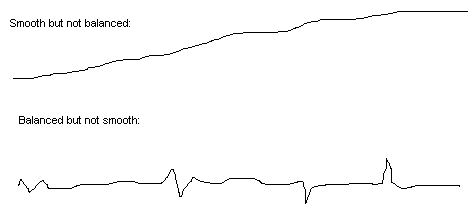
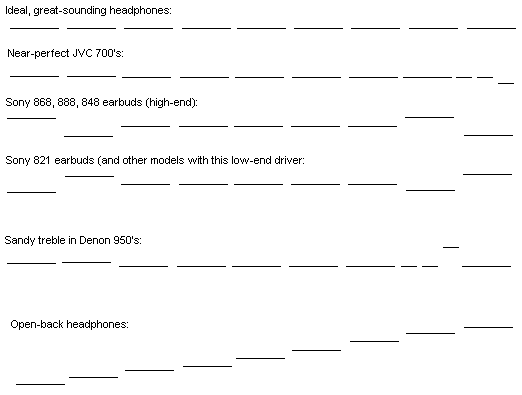
(The earbud curves above assume using a standard bass-boost compensation curve.)
Smoothness is fine-level response from one frequency to the next (such as 16,000 Hz vs. 16,100 Hz). Balance is broad-level response of the entire bass region, mid region, and treble region. By "smoothness" I mean breaking the spectrum into many narrow bands and comparing volume levels of adjacent bands. By "balance" I mean breaking the spectrum into 3 or 9 bands, and comparing the volume levels in each of these broad bands, whether adjacent or distant.
The bass drum should be about as prominent as the cymbals, and all the frequencies in between should get their fair share of prominence too. Cymbals shouldn't steal attention from the bass drum, and vice versa, and the guitar needs to sound warm too. Equal opportunity for all waves, long, short, and in-between.
From: Sergey Belonozhko
Subject: Equalization
>I have read your article about ear-buds and I like it. You have taken a really important question about equalization. You are right that all portable players have to have equalization (preset or manual). And now the best way is to buy portable amplifer from Headphone, but it's "a little bit" expensive for most of the listeners. I found something very cheap (in comparison to Headphone amplifer), but may be helpful (I didn't try it yet). It's Koss portable equalizer (not amplifer!) which allows 3-band stereo equalization. Koss's crummy headphone equalizer
This is the worst piece of equipment I have ever tried. I tried all combinations of volume pot settings, but the bottom line is, this has no headroom at all -- there is no space between its noise level and the point at which it distorts. Do not buy the Koss! -- hoff
>If it doesn't work just try www.koss.com and find eq/30 equalizer there in Portable Accessories. Please, write what do you think about. Probably, I'm gonna use it with Koss ksc/35 sportclips or with Sony 817.
>Thanks,
>Sergey
Use the cushions; they make the bass much louder. One earbud enthusiast has a collection of earbuds and uses cushions over the cushions, claiming significantly more bass than one layer of cushions -- definitely worth an experiment, given that there is an amazing, total difference between no cushions and one layer of cushions.
The 238's don't have cushions... Adding (customized) cushions to the 238s *might* make them have even more bass, but I don't know if they would have enough low-bass to match their mid-bass.
Use cushions (felt/foam) with earbuds. This gives much better bass! Bass also depends on your ear shape.
Earbuds have no bass when I take the cushions off, but relatively awesome bass when the cushions are used. Does anyone have a hypothesis for this? It's striking - night and day. Now when I say "earbuds can sound excellent" I make sure to say *with the cushions on* as well as "with some bass boost".
This is a *huge* bass boost effect, so take note and be sure to do a comparison test of with/without cushions! Note that the contoured Sony 238 earbuds have no cushions.
The Sony packages say "if the size is too small to fit right, then use the cushions". But that's bad advice. The cushions are mandatory, to get loud bass. The smaller 817's are the right size, if the cushions are used. The 868's are perhaps too big, if the cushions are used; they are heavy and big; I imagine they flop away from my ears, especially with the asymetrical cable, that pulls down on the left earbud. The Sony low-end earbuds are so light and small, they can be placed right up against the ear canal, and they stay there. I don't know about other people's ears, though; ear shape variation (and psychoacoustic variation) could explain why people give conflicting advice about earbuds. (See also Coupling.)
Bigger drivers and better stated response do not necessarily mean louder resulting bass. Tight coupling with the ear is the dominant factor, and small size can couple better with some ears. The high-end Sony earbuds are big, which seems like it would be better, but at least initially, these seem to effectively have *less* bass than the low-end earbuds. With earbuds, the coupling with the ear canal is 90% of the bass problem. Making the driver bigger actually can make for poorer coupling with the ear, and thus, *less* bass. We Americans have trouble with the concept "small performs better than big".
See also Sony 238 Earbuds.
Sony low-end earbuds: each channel's unit is one-piece, no joint or narrow spot to break - indestructible. The low-end models are *solid*, literally, with no joint to break, between the driver and stem; it's one smooth curve of tough plastic with no narrowing.
Sony high-end earbuds have separate disk-and-stem, which can break -- I saw a broken one in the store; can't happen with low-end models.
For portable MD, good earbuds are the best way to go, I think. Walkmans etc. are a little out of style in the U.S., it seems to me, so I really want my portable system to be small and invisible, low-key. Over-the-head or behind-the-head are too visible. Near-invisible systems such as miniaturized MiniDisc players with earbuds are stylish, insofar as any system of equipment and wires can make you look stylish.
If earbuds don't fit your ears, try different shapes of earbuds. Or hook-over ears, or vertical. (Unfortunately, "try" usually means "spend $100+ buying several").
Your testing results may differ, depending on the unit, cushion, ear shape, eardrum, tastes, song mastering, and psychoacoustics. Many people are happy with each Sony earbud (low-end, 238, 888). Other people think earbuds are all sonic junk. All do need appropriate low-bass boosting, but megabass when properly designed, could perfectly compensate. E40's first megabass position is great except for the terrible fact of bridging the bass to mono.
When listening for bass response, don't be fooled by mid-bass. Listen to the *tone* of the bass, not just the quantity. Listen for the ratio of mid-bass to low-bass. Same for treble. Don't be fooled by loud mid-treble. A tinny (tin-like) sound often means loud mid-treble with a sharp drop. At both ends of the spectrum, beware of the hump-then-dropoff effect, which gives the illusion of wide frequency response, but stops short.
Radio Shack's 1/8" headphone extension cable is 20 feet long, and kind of thick. Sony has a nice extension: for $10, you get a 10-foot cable of nice, *thin* cable, and a 1/8" to 1/4" adapter -- better for earbuds. In fact, I recommend plugging the thick, long Radio Shack cable into your home stereo, then connect the thin short Sony extension, then your earbuds - it's most ergonomic as far as cable weight distribution. The extension's jack and the earbud's plug together are too heavy though; I'd love a lightweight microplug and microjack here, if they are secure and sturdy enough to walk on or yank.
Date: Fri, 20 Feb 1998 12:27:41 +0100
From: Peter Clijsters
>Hello from another MD freak,
>On your pages I read something about an eq'd crossfeed circuit, and information about it could be found at www.headspace.com. I din't find anything about it, could you please give me the exact URL of this page. BTW great job on the earbud thing. I myself use them to (when I have to that is, like walking in the streets), but most of the time a use the Sony MDR-D77 headphones. Have you tried these, what do you think of them?
>Thank you,
>Peter
Delayed eq'd crossfeed circuit, psychoacoustics of speaker placement
Their cheapest speaker-simulating headphone processor/amp
This delayed, eq'd crossfeed circuit that should be added to walkmans and all stereos' headphone jacks. It makes the ears think the speakers are placed away from the head, which should then sound a lot better.
I haven't heard the D77's.
Porta-Pro model has this new circuit! See Koss.com site.
See also the Sony so-called "vertical headphones" (over-the-head headband, with earbuds turned sideways). Note: no cushions here. What if you put cushions around them - wouldn't they have more bass, like earbuds? I saw another brand that had cushions on vertical micro-headphones.
I have had the $65-80 HA-D700 model for several years. I thought they were discontinued, but actually, they are just hard to find in the stores. I have compared them to many of the highest-rated headphones and I maintain that the 700s have the best combination of balance and smoothness of any headphones. They are my favorite headphone for flat-eq listening, such as the headphone jack of a home CD deck. They have the most balanced bass vs. mid vs. treble, and sound smooth from each frequency to the next.
The 700's are snug and comfortable. The HA-D700 needs a slight boost around 13kHz. They are warm and very tube-like without being muddy; they seem to have a medium-width emphasis through the lower mids. The bass is extremely good, strong but not boomy; closed-back but not boxy sounding. I really lucked out when I found these. I still think the Sennheiser 580's and the new high-end super-open Sony's are interesting and I would like a pair, but those are open-back and *must* have treble cut and bass boost, to sound balanced.
I have always hated the way the "sticky" rubber cord catches on my shoes so that when I stand up, it jerks the headphones *very hard* so that the left arm holding the driver finally broke, after 7 years. That problem was finally the death of those headphones (well, the earpads are worn out too). But I just ordered another pair and am looking forward to having their great response curve again. These and the Denon 950s have really solid packaging and great bass, but the Denon 950 sounds very sandy -- the opposite of the 700's smooth, ever so slightly mellow treble. That's the miracle of the 700s -- mellow yet broad response, no exagerrated treble, no exagerrated mids, no exagerrated bass -- all the bands work together, none of them standing out too much. Add a little treble and bass, and they really shine fully, all across the spectrum. The Sennheiser 580s, in comparison, have exagerrated high treble and almost no bass (they sound balanced only after you boost the bass a lot and cut the treble a lot).
I don't see the 700s on the JVC web site; only the 990's are there. To order them from the parts warehouse, see the 990 section below.
The 990's have different drivers than the 700's. The 900s are bigger and a little more sandy sounding -- they sound almost identical to the Denon 950s (but I didn't "break in" either pair; some people might claim that they would sound smoother after a year of use).
Since I just received my 990 headphones, and will receive my 700s soon, I will be doing a fair comparison: both headphones are new; neither has been "broken in". (I actually doubt there is any significant break-in effect for earbuds or headphones. Most jaggedness in a response curve is too intense for a mere break-in to erase.)
The 990s have unusually nice packaging -- they are sweet to handle and very good looking, and comfortable. They have a 1/4" plug, which I don't like (it's bad for using with a portable player).
The 990 is the top-of-the-line JVC headphones. I can't find any stores in Seattle that carry this model. I could call JVC and ask what stores have ordered this model, and try to find them in stock. The 990 has metal arms, so it won't crack and break. There are several phone numbers through which you can order these (probably non-returnable).
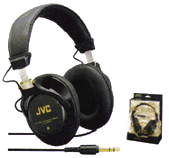
JVC Authorized Parts Distributors:
Very clunky packaging. Earpieces spin (takes effort to put the phones onto your head). Far too thick cables. Thick, sharp y-connector at your upper chest or back. Need bass boost and treble cut. Too much treble; in rock, cymbals are so loud, they block the rest of the spectrum. These don't sit securely on the head. Very weak where wire enters driver; can break in the store.
I think, "I would enjoy this music if you would stop banging that great-sounding cymbal right in my ear, drowning out the rest of the band." The treble in the Grado's sounds great, open, and smooth (a hard achievement) - there's just too much of it. Here I should clear up my statement about Sennheiser 580's and Grado 60's having "no bass" -- I mean, when you plug into the CD player's headphone jack, the treble is certainly too loud compared to the bass, though they both are smooth curves. The Grado's sound more balanced with bass at 3 o'clock and treble at 10 o'clock.
Thin peaky high treble (a sharp single-frequency hiss, not smooth/uniform across frequencies).
Date: Fri, 20 Feb 1998 16:49:52 -0500
From: John Hoffman -- theshadow at pointblank.com
>I use a pair of earbuds that came with RCA's old MD player; they're very good, though bass response is a little on the low side... I'll have to try some cushions, they didn't come with any...
>I *STRONGLY* recommend Denon AH-D210 headphones. They have an incredibly deep, clear bass response. The only thing I don't like about them is they're a bit larger than I'd like for portable use; otherwise they're ideal.
The Denon 950's are cozy, tons of bass. But the treble is fizzy, thin, 1-dimensional, not smoothe. I had to use my 10-band equalizer to make a jagged eq curve to smooth out the results. They seem to have a sharp peak around 16kHz - producing a sandy sound. Good packaging, blows away the Grado's. But I'm going to buy the $120 JVC 990's - very comparable to the Denon 950's in packaging. I haven't heard the 990's yet though. I will listen to the other Denon's in the store.
>I haven't tried the Denon 950, they're somewhat out of my price range, but I haven't noticed any problems with the treble.
Low bass response is to be expected with all earbuds. The part I'm critical of is, how smooth is the treble and mid's? -- hoff
>I'm afraid I'm not a musical gourmet, more of a gourmand; the sounds I listen to tend to wipe out any subtleties in the playback medium, aside from white noise, and increasing the range is the way to improve it.
>John Hoffman.
I like these. Nice packaging, though not so snug and cozy as the Denon 950's or JVC 990's. Open-air. Inefficient; too quiet for walkmans. Breakable where wires enter drivers; often broken here in the stores. Sound similar to Grado's: need bass boost and treble cut for balanced rock sound. Smooth, but not balanced; tilted toward treble like a flat up-ramp across the spectrum.
Steve wrote:
>The choice of many recording engineers are the AKG 240 or 240M's. I know several very good freelance and staff engineers who alway carry a pair because they are not sure what the montitors will be like in any particular studio. I've seen them mainly used for referencing while tracking or checking mixes, but also watched a very good engineer use them as the basic monitors in a project studio that had a poor control room listening evvironment. He mixed the project on them then 'referenced ' through the studio's speakers, small aurotones, a boombox and a car cassette player.
>Since they are closed ear they can also be used for tracking if the there is no control room and the console is in the same room (or nearby) as the players.
>They are very comfortable to wear and extremely flat. I have a pair for my modest studio, but really enjoy them for other uses like plugging into a preamp or hifi VCR. The list for about $100 but can be had for $89 on sale. They are worth the extra money.
>Steve
"The 888 earbuds come really close to my AKG 270 (which is not intended for portable use at all (and cost twice as much))."
Very good bass, fairly good treble. Recommended by many people. $40; on sale every other month for only $20. Not the same as Koss Porta Pro Jr; it's a myth that these are the same. They are indeed made by Koss, says "Koss" on the plug casing. Cover ears mostly. Very nice fit, more secure than Grado's; comfortable. Porta Pro users say the Pro 25s are less comfortable for extended listening.
These are bass monsters -- perhaps too much bass, relative to the treble. I'd like to A/B them against the Porta Pro Jr, which supposedly are slanted toward the treble (too much?).
Foldable. Recommended by many, for highly compact, portable players such as MiniDisc and MP3 players. Compare Radio Shack Pro-25 (by Koss). Headband. Supraaural. Above-ear temple pressure pads relieve ear pressure.
Info from Koss Home page -- lots of headphone models and accessories
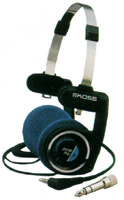
Porta Pro Jr.
Frequency Response: 15-25,000 Hz
Multi-pivoting earplates and adjustable for added comfort
Collapsible for maximum portability and flexibility
Straight, 4-foot cord
1/8" and 1/4" stereo plugs for home and portable use
$39.99
Recommended by many. Bigger version of Porta Pro Jr. (Bigger, so less compact, less portable.)
"Koss Porta Pro is 'warmer' than the 888 earbuds, but a bit muddy in bass and midrange, and not so huge and spacious."
Clip-over ears, no headband. Cover ears mostly. Same driver as Porta Pro Jr. Recommended by many.
"The Sony MDR-D65 has thin tinny treble and tiny bass because the connection to my head is not good."
>Recently I tried Sony's StreetSound (there are two models here, I bought the most expensive one, $30) model that covers the ear completely. This design could actually be excellent, but they were disappointing, yet the concept is very promising. If they would make a high end model of this concept, it could be a winner.
>Best regards,
>Peter
rec.audio.pro,rec.audio.tech,alt.music.mp3,rec.audio.misc,rec.audio.opinion,alt.audio.minidisc
These sort of queries are cool. You can set up a query to view thread, view newsgroup sorted by thread or date or relevance, etc.
Subject: Re: Stax Headphones
Hello Webmaster,
Yama's Enterprises Inc. is the U.S. distributors of STAX electrostatic audio products. If you have inquiries either from yourself or your visitors, please visit our website at http://www.yamasinc.com. New product information is available at that site and we check our e-mails daily.
Love your site...
Sincerely,
Collin Imai
General Manager
Yama's Enterprises Inc